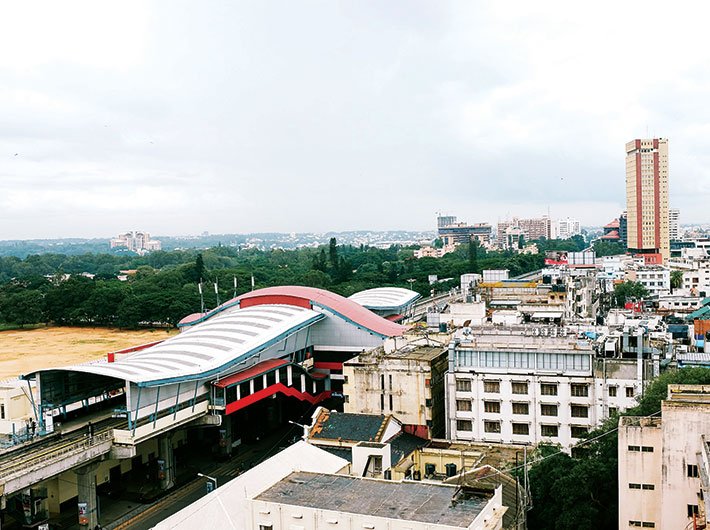Bengaluru’s growth in area as well as in population calls for a fresh look at its administrative setup and a panel is looking into splitting the civic body
Mega cities are difficult to govern. A monolithic administration is not responsive to citizens primarily because of its structure of layers of officials. Modern cities require a different setup to implement best practices of civic governance.
One mega city that is re-examining its existence in its present form is Bengaluru, the IT capital of India and state capital of Karnataka.
The city has had some of the best civil society groups involved in Bengaluru’s development but has suffered due to ad hoc decisions of the administration. Now, there is talk of having two or more administrative units for the city.
World over no city with over eight million population is governed by one civic body (Bruhat Bengaluru Mahanagara Palike, or BBMP). Taking lessons from cities across the globe, Bengaluru may opt for multi-municipal corporations. The challenges and consequences of the proposed multi-municipal governance structure in Bengaluru are being debated.
The seeds of the debate began long before the interim report of the BS Patil committee, which was set up in September last year to restructure BBMP for better administration. The panel headed by former chief secretary BS Patil, which submitted its interim report to chief minister Siddaramaiah on December 23 last year, has compared many cities of the world and given reasons why BBMP should be split.
However, the committee has not decided whether the Palike should be bifurcated or trifurcated and has sought six more months for a detailed study on the ways and means to split the city’s administrative setup.
As the committee gets down to serious business of examining Bengaluru’s future needs, Governance Now spoke to experts on various facets of the issue.
1. Philip van Ryneveld is an expert on urban restructuring. Ryneveld was the chief finance officer, City of Cape Town municipality. He also worked in Tamil Nadu looking at how metropolitan government might be introduced in that state.
2. V Ravichandar is a Bengaluru-based urban expert. He has been on various civil society groups and chairman of Feedback Consulting. He is member of the committee set up to examine BBMP’s restructuring.
3. Ashwin Mahesh is also a Bengaluru-based civic expert and faculty member of Indian Institute of Management, Bengaluru.
4. Christopher Kost is technical director at the Institute for Transportation and Development Policy (ITDP), Chennai.
Management problems
Philip van Ryneveld says the key challenge is that there is often contestation over power and jurisdictional authority in such a system. This can make it more difficult to get things done. It is important in such a system (as with any system) that there be clarity of accountability. “Poorly managed, the introduction of a two-tier system can lead to an unnecessary bloating of the administration. There is a danger that the metropolitan level is seen as a threat in terms of power to both lower level municipalities and the state government level. By suggesting a metropolitan tier, Bengaluru is taking an important step forward. However, such systems can be complex, and it is crucial that the change is well managed,” he suggests.
A well designed two-tier metropolitan system is significantly better than a single tier system made up of a number of small municipalities unable to address the metropolitan-wide issues because none of them have wide enough jurisdictions, Ryneveld said.
V Ravichandar feels that the exercise is to suggest to the Karnataka government the best way ahead to restructure the single corporation. The BBMP manages 98 wards in the city. It is felt that a single city corporation has become too unwieldy to manage over 10 million population in a 800 sq km area. There is need to consider multiple corporations.
“While doing so it is also realised we need a regional governance and administrative arrangement that works across the greater Bengaluru metropolitan area. That’s the rationale for setting up a three-member expert committee for BBMP restructuring. If we look at models globally, once cities cross 8 million population, they invariably have multi-municipal governance structures – some had them when they were much smaller and some chose to split as the population rose. The feeling appears to be that smaller governance units are closer to meeting citizen needs,” said Ravichandar.
Ashwin Mahesh says, many urban areas, including Chennai already have multiple cities within them. Chennai, Tambaram, Porur, Poonamallee, and a few other municipal areas all together constitute what we loosely refer to as ‘Chennai’.
“The metropolitan region around cities is even larger, typically enough to include satellite towns like Chengelpet or Sriperambudur. What we have learned during the growth of urbanisation in other countries is that as urban regions grow, we need a mechanism for regional governance too, not just the governance of each city within the metropolitan region. It is this regional governance that was called for in the 74th constitutional amendment in 1992. So far, no state has implemented this properly. Without a regional understanding it will be difficult to bring coherence to the way in each city within the region operates,” he said.
Key challenges in multi structure
The biggest challenge so far in the country is that state governments don’t want to give up the power they have over cities, and have therefore not implemented metropolitan governance properly, says Ashvin Mahesh. Here and there the courts have been pushing the State, as in Karnataka. “We will get there eventually, I am sure, but it would be so much better if we did it proactively and with confidence rather than under court duress,” he says.
Christopher Kost says, while devolution of administrative functions may bring about improvements in service delivery, it is essential to have an umbrella metropolitan government headed by a democratically elected mayor that can look after the entire greater Bengaluru area. Land use planning and transport services—including both buses and metro rail—should be brought under this metropolitan government to facilitate coordinated decision making.
In Delhi the municipal corporation was trifurcated in 2012. And now there is a debate on the parking policy because after the corporation was split up, different policies were adopted by different corporations. It causes inconvenience to public, adds Kost.
Mahesh says there is nothing wrong if different municipal areas follow different rules for local matters. In fact, it may be necessary. In central areas, you can have a policy based on high density of people. In outlying areas you will not. That is quite natural. A good metropolitan authority should be able to distinguish between the needs of different cities, and allow / facilitate diversity of thinking and planning in each one.

